|
Annex A: Regional Trends and Variations of Temperature and Precipitation
IPCC (1996) provided time-series plots and global maps depicting trends of
precipitation and temperature. This Annex extends and updates these records
for a broader number of contiguous regions.
Two data sets are used to represent near-surface air temperature change. Over
land this includes a near-surface air temperature data set developed by Jones
(1994), and over the oceans a sea-surface temperature data set developed by
Folland and Parker (1995). Both of these data sets provide the basis for calculating
global temperature change as reported in the IPCC Second Assessment Report (1996).
Parker et al. (1994) describe the methodology used to aggregate land and ocean
temperatures for grid cells that span both regions.
Precipitation changes are also calculated from two data sets. Land-surface
precipitation data are derived and updated from Hulme (1991) and from Eischeid
et al. (1995); the latter is referred to as the GHCN (version 1) data set in
IPCC (1996). Both data sets were available with a resolution of 5°x5°. Since
two data sets were used, a procedure was needed to integrate the data. A simple
equal weighting scheme was used when both data sets had data available. For
some grid cells, data were available from only one data set, and this provided
additional coverage relative to the use of a single data set.
In Figures A-1 and A-2, the magnitude of the trends of precipitation and temperature
for each 5°x5° grid cell is given by the area of circle centered in each cell;
brown and blue circles reflect decreasing trends, and green and red circles
increasing trends. Trends are given in %/century for precipitation and °C/century
for temperature. Precipitation trends are expressed in percent relative to the
1961-90 average precipitation.
Time-series plots of the annual anomalies of precipitation and temperature
(relative to 20th century averages) are depicted for each of the various regions
delineated in Figure A-3. For those regions where a 5°x5° grid cell spanned
two or more regions, the anomalies for that grid cell were used more than once-once
for each region that intersected the grid cell. The time series depicted in
Figures A-4 through A-13 show the anomalies from the 1961-90 means. Longer term
variation of these annual anomalies are emphasized by a smooth curve using a
nine-point binomial filter.
Time-series plots of precipitation are not provided for Antarctica, due to
very poor spatial coverage and large data uncertainties. The trends of temperature
for the small island states include both land and ocean sea-surface temperature
trends for grid cells that include both land and ocean.
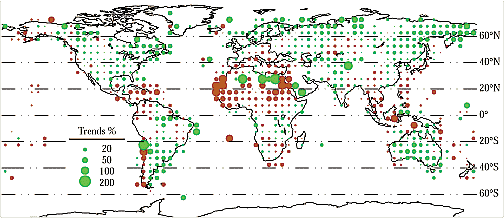 |
| Figure A-1: Precipitation-Annual 1901-1995. |
 |
| Figure A-2: Temperature-Annual 1901-1996. |
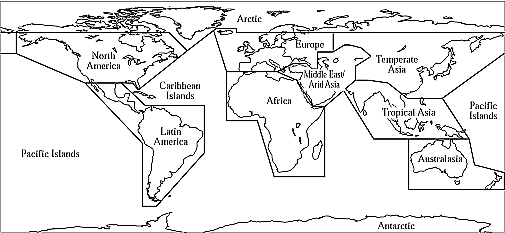 |
| Figure A-3: GIS mask used to define the 10 regions covered in this
Special Report. |
 |
 |
| Figure A-4: Observed annual precipitation (top) and temperature
(bottom) changes for the Africa region. |
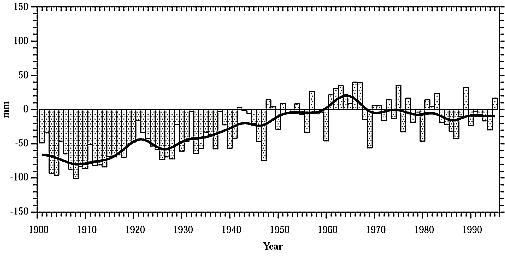 |
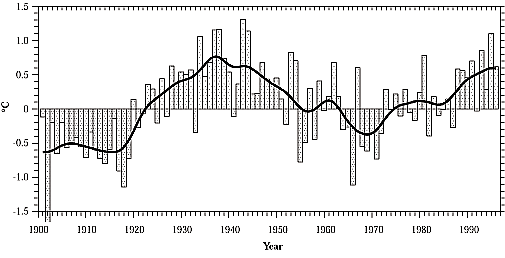 |
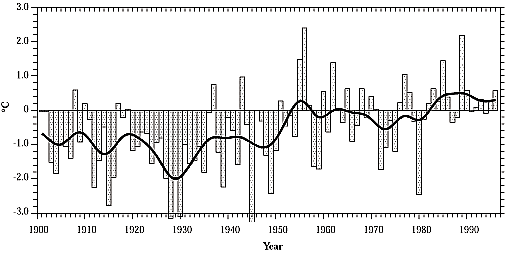 |
| Figure A-5: Observed annual precipitation [top (Arctic)] and temperature
[middle (Arctic) and bottom (Antarctica)] changes for the Arctic/Antarctica
region. |
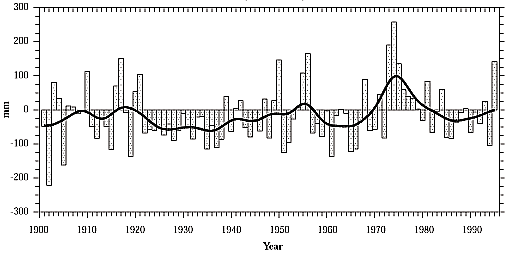 |
 |
| Figure A-6: Observed annual precipitation (top) and temperature
(bottom) changes for the Australasia region. |
 |
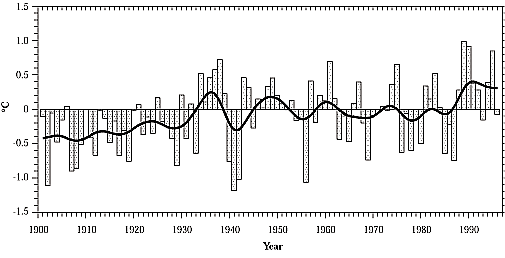 |
| Figure A-7: Observed annual precipitation (top) and temperature
(bottom) changes for the Europe region. |
 |
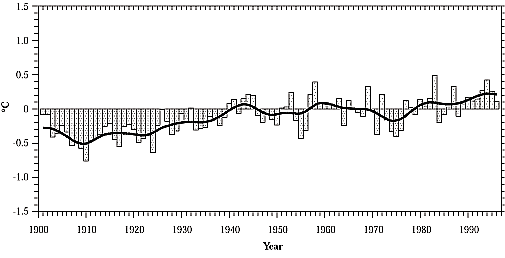 |
| Figure A-8: Observed annual precipitation (top) and temperature
(bottom) changes for the Latin America region. |
 |
 |
| Figure A-9: Observed annual precipitation (top) and temperature
(bottom) changes for the Middle East/Arid Asia region. |
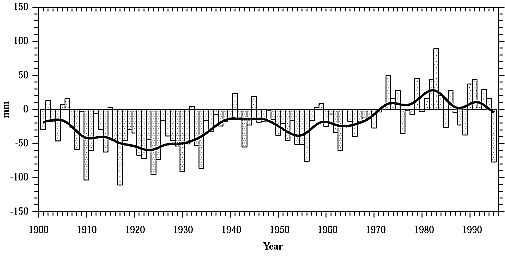 |
 |
| Figure A-10: Observed annual precipitation (top) and temperature
(bottom) changes for the North America region. |
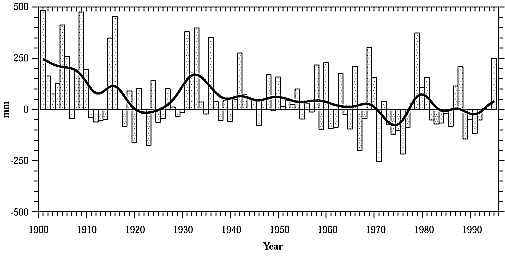 |
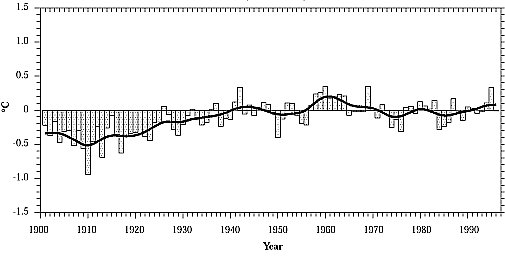 |
| Figure A-11: Observed annual precipitation (top) and temperature
(bottom) changes for the Caribbean island component of the Small Island
States region. |
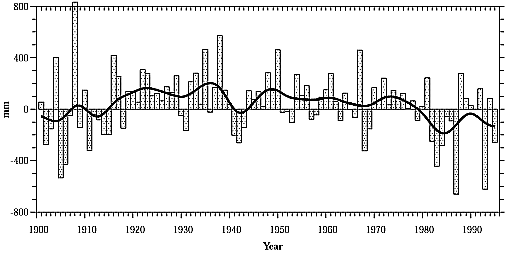 |
 |
| Figure A-11 (continued): Observed annual precipitation (top) and
temperature (bottom) changes for the Pacific island component of the Small
Island States region. |
 |
 |
| Figure A-12: Observed annual precipitation (top) and temperature
(bottom) changes for the Temperate Asia region. |
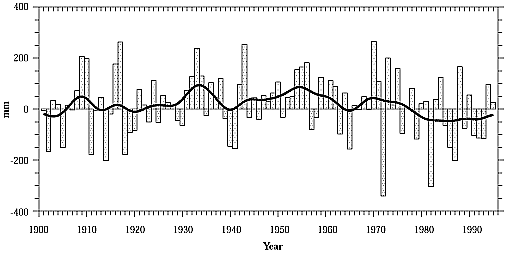 |
 |
| Figure A-13: Observed annual precipitation (top) and temperature
(bottom) changes for the Tropical Asia region. |
References
Eischeid, J.K., C.B. Baker, T.R. Karl, and H.F. Diaz, 1995:
The quality control of long-term climatological data using objective data
analysis. Journal of Applied Meteorology, 34, 2787-2795.
Folland, C.K. and D.E. Parker, 1995:
Correction of instrumental biases in historical sea-surface temperature data.
Quarterly Journal of the Royal Meteorological Society, 121, 319-367.
Hulme, M., 1991:
An intercomparison of model and observed global precipitation climatologies.
Geophysical Research Letters, 18, 1715-1718.
IPCC, 1996:
Climate Change 1995: The Science of Climate Change. Contribution of Working
Group I to the Second Assessment Report of the Intergovernmental Panel on
Climate Change [Houghton, J.J., L.G. Meiro Filho, B.A. Callander, N. Harris,
A. Kattenberg and K.Maskell (eds.)]. Cambridge University Press, Cambridge
and New York, 572 pp.
Jones, P.D., 1994:
Hemispheric surface air temperature variations: A reanalysis and an update
to 1993. Journal of Climate, 3, 1794-1802.
Parker, D.E., P.D. Jones, C.K. Folland, and A. Bevan, 1994:
Interdecadal changes of surface temperature since the late 19th century.
Journal of Geophysical Research, 99, 14373-14399.
|